Evaluating Diversity and Inclusion Strategies: A Tesco Plc Project
VerifiedAdded on 2023/01/19
|32
|6372
|20
Project
AI Summary
This project is a comprehensive analysis of Tesco Plc's strategies and initiatives for developing a diverse and inclusive workforce. It begins with an introduction defining equality and diversity, and provides background information on Tesco Plc, its operations, and its commitment to diversity. The project outlines the aim, objectives, and research questions, followed by a project management plan including cost analysis, risk assessment, and time management considerations. A Gantt chart and work breakdown structure are included to visualize project timelines and tasks. The research methodology section details the research philosophy (Interpretivism), research type (qualitative), research approach (Inductive), and data collection methods (primary and secondary). The project presents a literature review, data analysis and interpretation, recommendations for developing equality and diversity, and concludes with a reflection. The research explores the impact of a diverse workforce and offers strategies for improvement. The project encompasses various aspects of project management, research, and analysis to provide a detailed understanding of Tesco's approach to diversity and inclusion.
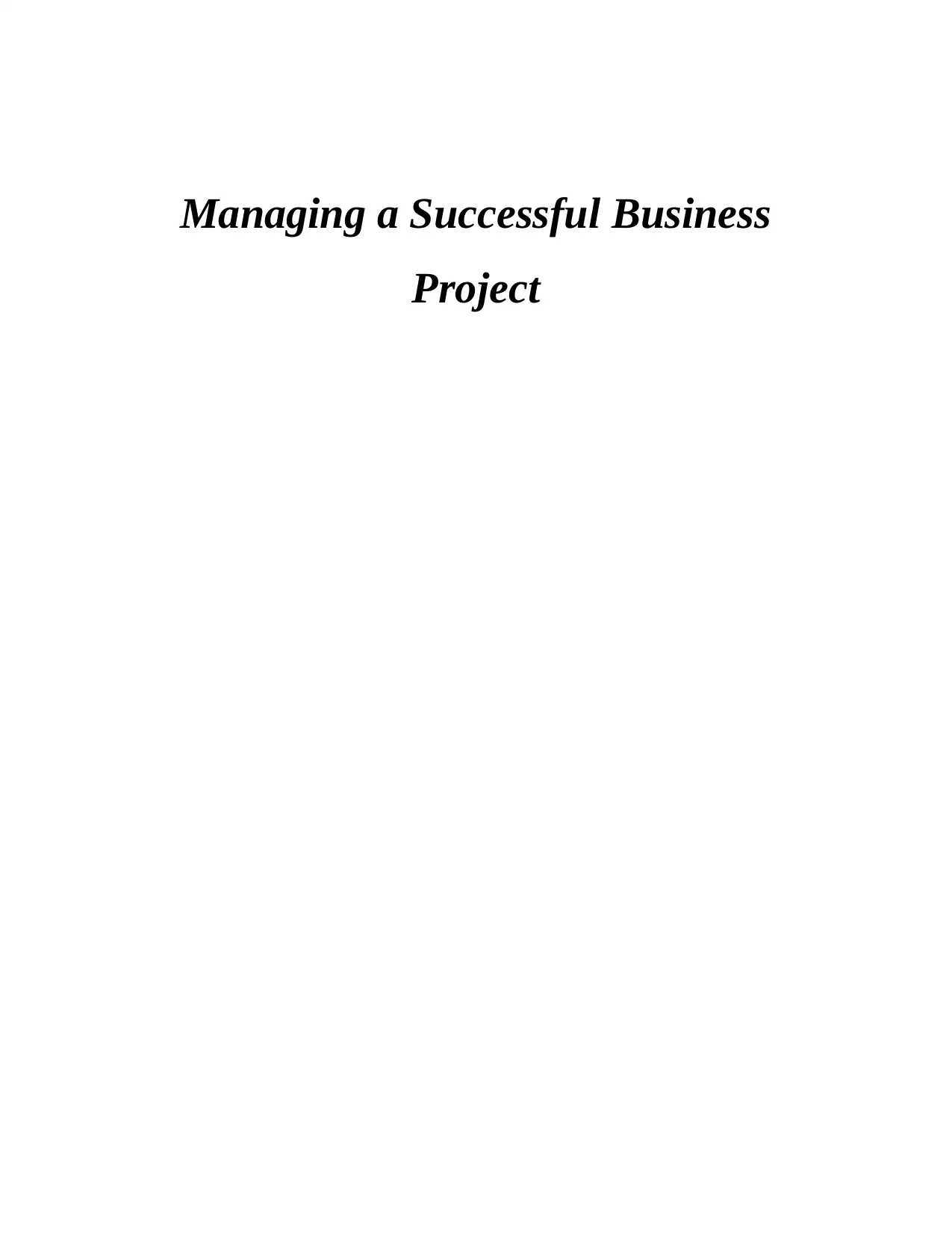
Managing a Successful Business
Project
Project
Paraphrase This Document
Need a fresh take? Get an instant paraphrase of this document with our AI Paraphraser
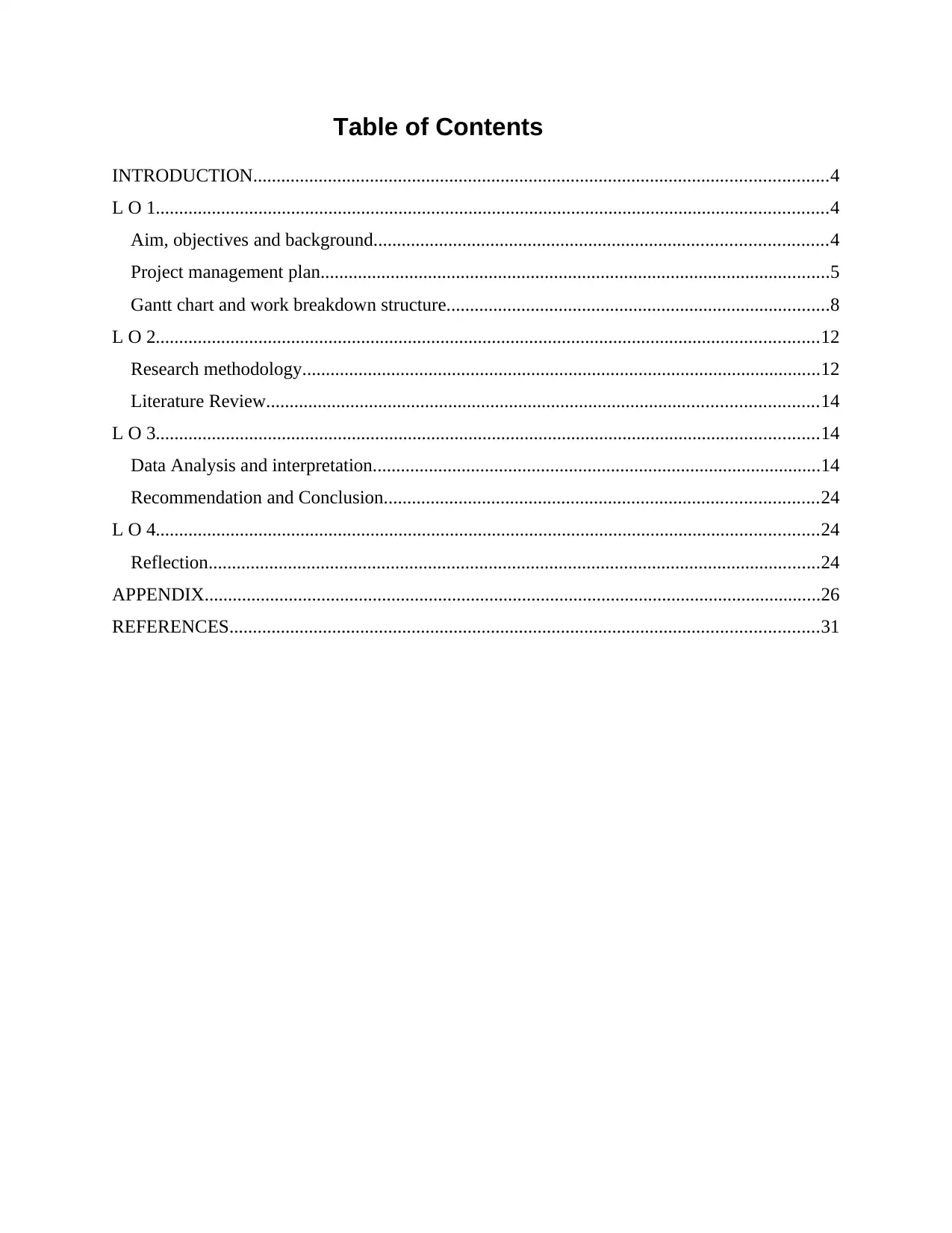
Table of Contents
INTRODUCTION...........................................................................................................................4
L O 1................................................................................................................................................4
Aim, objectives and background.................................................................................................4
Project management plan.............................................................................................................5
Gantt chart and work breakdown structure..................................................................................8
L O 2..............................................................................................................................................12
Research methodology...............................................................................................................12
Literature Review......................................................................................................................14
L O 3..............................................................................................................................................14
Data Analysis and interpretation................................................................................................14
Recommendation and Conclusion.............................................................................................24
L O 4..............................................................................................................................................24
Reflection...................................................................................................................................24
APPENDIX....................................................................................................................................26
REFERENCES..............................................................................................................................31
INTRODUCTION...........................................................................................................................4
L O 1................................................................................................................................................4
Aim, objectives and background.................................................................................................4
Project management plan.............................................................................................................5
Gantt chart and work breakdown structure..................................................................................8
L O 2..............................................................................................................................................12
Research methodology...............................................................................................................12
Literature Review......................................................................................................................14
L O 3..............................................................................................................................................14
Data Analysis and interpretation................................................................................................14
Recommendation and Conclusion.............................................................................................24
L O 4..............................................................................................................................................24
Reflection...................................................................................................................................24
APPENDIX....................................................................................................................................26
REFERENCES..............................................................................................................................31
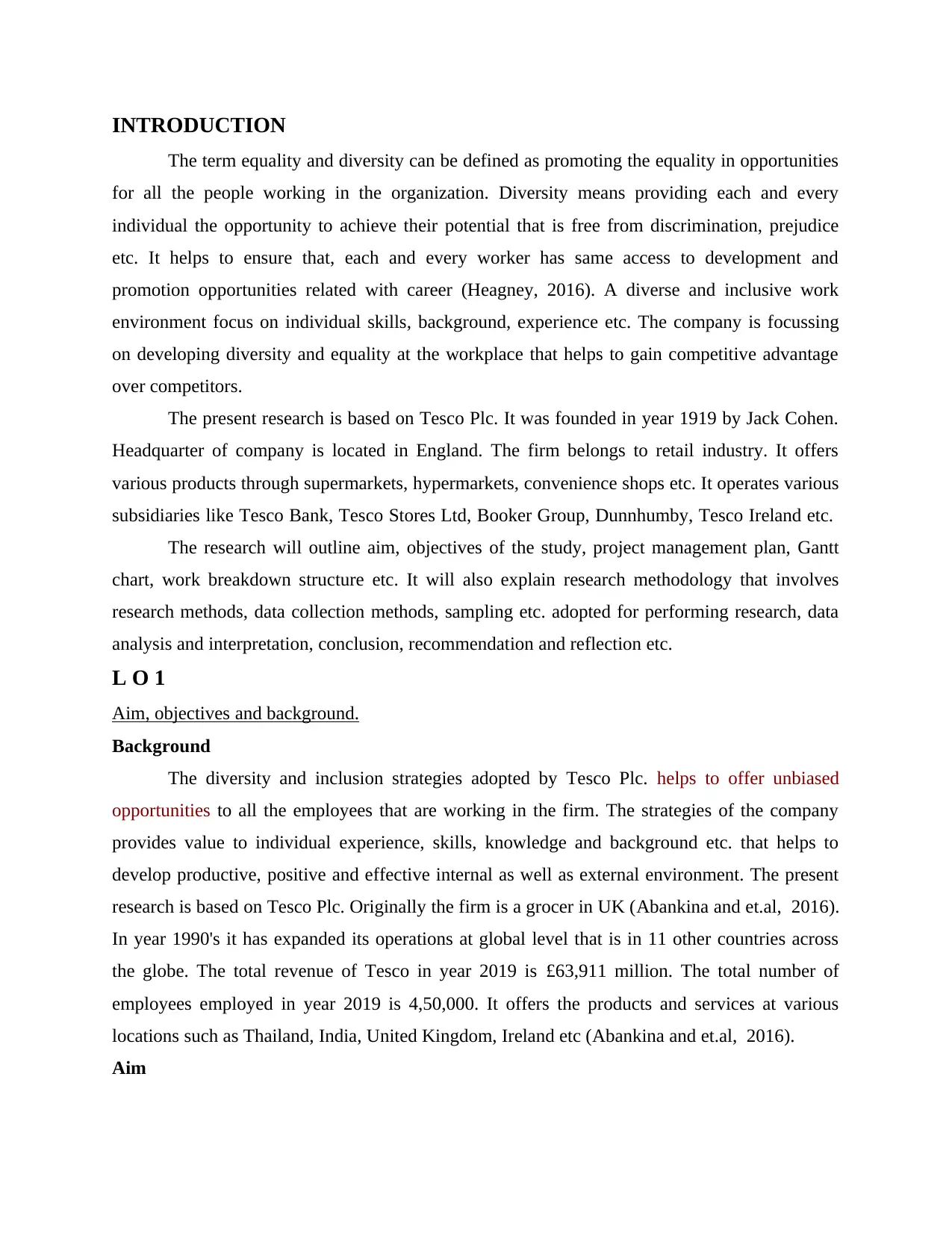
INTRODUCTION
The term equality and diversity can be defined as promoting the equality in opportunities
for all the people working in the organization. Diversity means providing each and every
individual the opportunity to achieve their potential that is free from discrimination, prejudice
etc. It helps to ensure that, each and every worker has same access to development and
promotion opportunities related with career (Heagney, 2016). A diverse and inclusive work
environment focus on individual skills, background, experience etc. The company is focussing
on developing diversity and equality at the workplace that helps to gain competitive advantage
over competitors.
The present research is based on Tesco Plc. It was founded in year 1919 by Jack Cohen.
Headquarter of company is located in England. The firm belongs to retail industry. It offers
various products through supermarkets, hypermarkets, convenience shops etc. It operates various
subsidiaries like Tesco Bank, Tesco Stores Ltd, Booker Group, Dunnhumby, Tesco Ireland etc.
The research will outline aim, objectives of the study, project management plan, Gantt
chart, work breakdown structure etc. It will also explain research methodology that involves
research methods, data collection methods, sampling etc. adopted for performing research, data
analysis and interpretation, conclusion, recommendation and reflection etc.
L O 1
Aim, objectives and background.
Background
The diversity and inclusion strategies adopted by Tesco Plc. helps to offer unbiased
opportunities to all the employees that are working in the firm. The strategies of the company
provides value to individual experience, skills, knowledge and background etc. that helps to
develop productive, positive and effective internal as well as external environment. The present
research is based on Tesco Plc. Originally the firm is a grocer in UK (Abankina and et.al, 2016).
In year 1990's it has expanded its operations at global level that is in 11 other countries across
the globe. The total revenue of Tesco in year 2019 is £63,911 million. The total number of
employees employed in year 2019 is 4,50,000. It offers the products and services at various
locations such as Thailand, India, United Kingdom, Ireland etc (Abankina and et.al, 2016).
Aim
The term equality and diversity can be defined as promoting the equality in opportunities
for all the people working in the organization. Diversity means providing each and every
individual the opportunity to achieve their potential that is free from discrimination, prejudice
etc. It helps to ensure that, each and every worker has same access to development and
promotion opportunities related with career (Heagney, 2016). A diverse and inclusive work
environment focus on individual skills, background, experience etc. The company is focussing
on developing diversity and equality at the workplace that helps to gain competitive advantage
over competitors.
The present research is based on Tesco Plc. It was founded in year 1919 by Jack Cohen.
Headquarter of company is located in England. The firm belongs to retail industry. It offers
various products through supermarkets, hypermarkets, convenience shops etc. It operates various
subsidiaries like Tesco Bank, Tesco Stores Ltd, Booker Group, Dunnhumby, Tesco Ireland etc.
The research will outline aim, objectives of the study, project management plan, Gantt
chart, work breakdown structure etc. It will also explain research methodology that involves
research methods, data collection methods, sampling etc. adopted for performing research, data
analysis and interpretation, conclusion, recommendation and reflection etc.
L O 1
Aim, objectives and background.
Background
The diversity and inclusion strategies adopted by Tesco Plc. helps to offer unbiased
opportunities to all the employees that are working in the firm. The strategies of the company
provides value to individual experience, skills, knowledge and background etc. that helps to
develop productive, positive and effective internal as well as external environment. The present
research is based on Tesco Plc. Originally the firm is a grocer in UK (Abankina and et.al, 2016).
In year 1990's it has expanded its operations at global level that is in 11 other countries across
the globe. The total revenue of Tesco in year 2019 is £63,911 million. The total number of
employees employed in year 2019 is 4,50,000. It offers the products and services at various
locations such as Thailand, India, United Kingdom, Ireland etc (Abankina and et.al, 2016).
Aim
⊘ This is a preview!⊘
Do you want full access?
Subscribe today to unlock all pages.

Trusted by 1+ million students worldwide
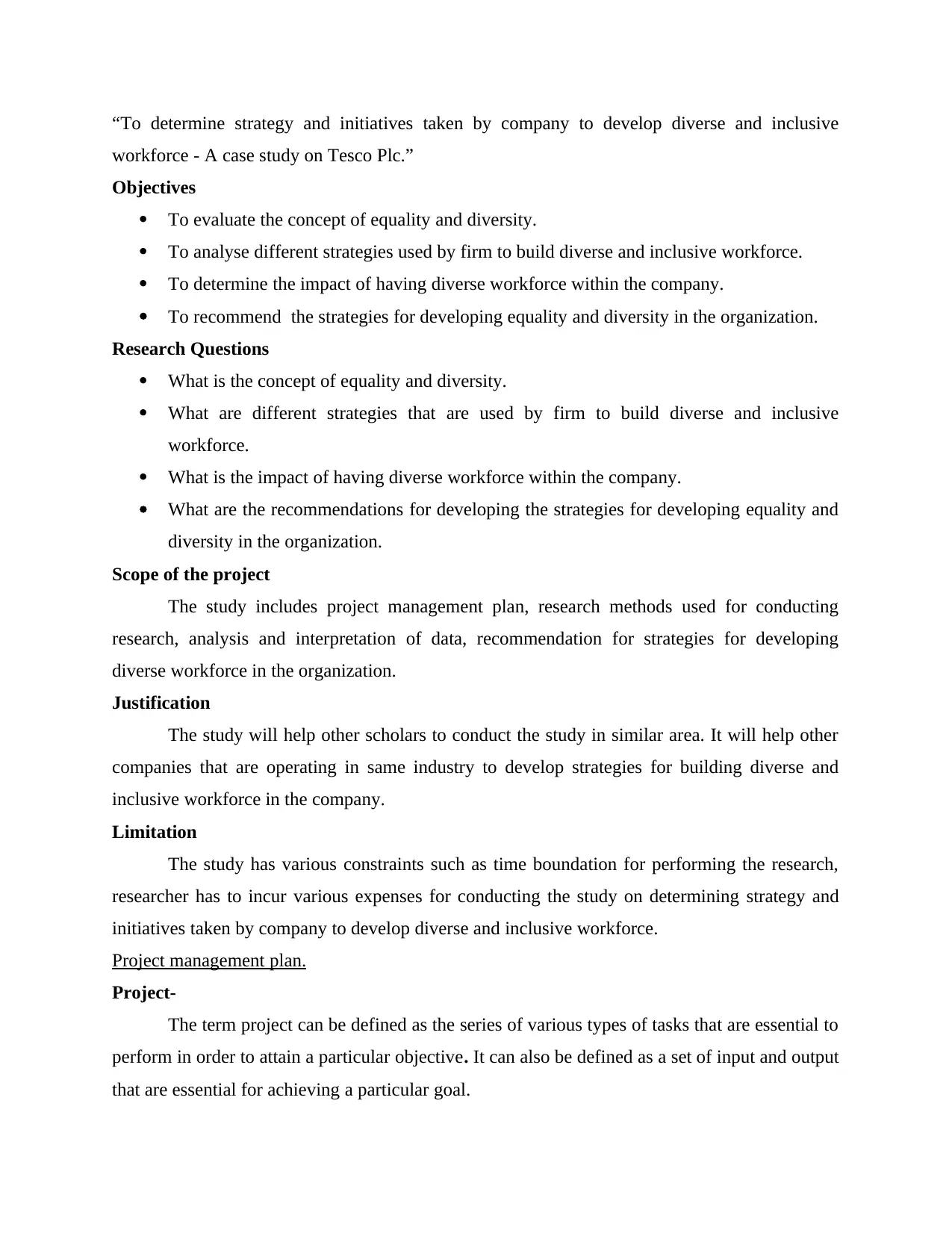
“To determine strategy and initiatives taken by company to develop diverse and inclusive
workforce - A case study on Tesco Plc.”
Objectives
To evaluate the concept of equality and diversity.
To analyse different strategies used by firm to build diverse and inclusive workforce.
To determine the impact of having diverse workforce within the company.
To recommend the strategies for developing equality and diversity in the organization.
Research Questions
What is the concept of equality and diversity.
What are different strategies that are used by firm to build diverse and inclusive
workforce.
What is the impact of having diverse workforce within the company.
What are the recommendations for developing the strategies for developing equality and
diversity in the organization.
Scope of the project
The study includes project management plan, research methods used for conducting
research, analysis and interpretation of data, recommendation for strategies for developing
diverse workforce in the organization.
Justification
The study will help other scholars to conduct the study in similar area. It will help other
companies that are operating in same industry to develop strategies for building diverse and
inclusive workforce in the company.
Limitation
The study has various constraints such as time boundation for performing the research,
researcher has to incur various expenses for conducting the study on determining strategy and
initiatives taken by company to develop diverse and inclusive workforce.
Project management plan.
Project-
The term project can be defined as the series of various types of tasks that are essential to
perform in order to attain a particular objective. It can also be defined as a set of input and output
that are essential for achieving a particular goal.
workforce - A case study on Tesco Plc.”
Objectives
To evaluate the concept of equality and diversity.
To analyse different strategies used by firm to build diverse and inclusive workforce.
To determine the impact of having diverse workforce within the company.
To recommend the strategies for developing equality and diversity in the organization.
Research Questions
What is the concept of equality and diversity.
What are different strategies that are used by firm to build diverse and inclusive
workforce.
What is the impact of having diverse workforce within the company.
What are the recommendations for developing the strategies for developing equality and
diversity in the organization.
Scope of the project
The study includes project management plan, research methods used for conducting
research, analysis and interpretation of data, recommendation for strategies for developing
diverse workforce in the organization.
Justification
The study will help other scholars to conduct the study in similar area. It will help other
companies that are operating in same industry to develop strategies for building diverse and
inclusive workforce in the company.
Limitation
The study has various constraints such as time boundation for performing the research,
researcher has to incur various expenses for conducting the study on determining strategy and
initiatives taken by company to develop diverse and inclusive workforce.
Project management plan.
Project-
The term project can be defined as the series of various types of tasks that are essential to
perform in order to attain a particular objective. It can also be defined as a set of input and output
that are essential for achieving a particular goal.
Paraphrase This Document
Need a fresh take? Get an instant paraphrase of this document with our AI Paraphraser
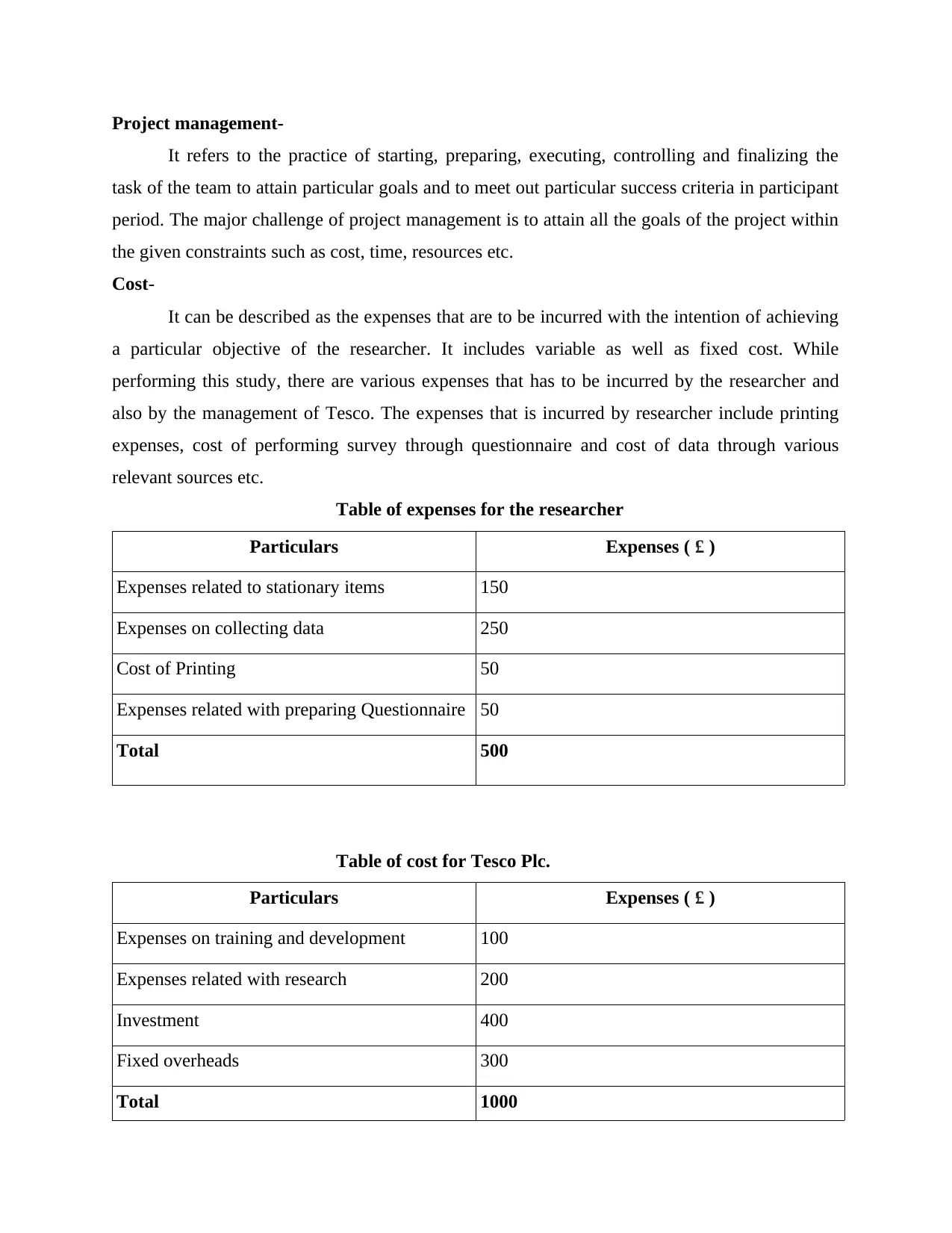
Project management-
It refers to the practice of starting, preparing, executing, controlling and finalizing the
task of the team to attain particular goals and to meet out particular success criteria in participant
period. The major challenge of project management is to attain all the goals of the project within
the given constraints such as cost, time, resources etc.
Cost-
It can be described as the expenses that are to be incurred with the intention of achieving
a particular objective of the researcher. It includes variable as well as fixed cost. While
performing this study, there are various expenses that has to be incurred by the researcher and
also by the management of Tesco. The expenses that is incurred by researcher include printing
expenses, cost of performing survey through questionnaire and cost of data through various
relevant sources etc.
Table of expenses for the researcher
Particulars Expenses ( £ )
Expenses related to stationary items 150
Expenses on collecting data 250
Cost of Printing 50
Expenses related with preparing Questionnaire 50
Total 500
Table of cost for Tesco Plc.
Particulars Expenses ( £ )
Expenses on training and development 100
Expenses related with research 200
Investment 400
Fixed overheads 300
Total 1000
It refers to the practice of starting, preparing, executing, controlling and finalizing the
task of the team to attain particular goals and to meet out particular success criteria in participant
period. The major challenge of project management is to attain all the goals of the project within
the given constraints such as cost, time, resources etc.
Cost-
It can be described as the expenses that are to be incurred with the intention of achieving
a particular objective of the researcher. It includes variable as well as fixed cost. While
performing this study, there are various expenses that has to be incurred by the researcher and
also by the management of Tesco. The expenses that is incurred by researcher include printing
expenses, cost of performing survey through questionnaire and cost of data through various
relevant sources etc.
Table of expenses for the researcher
Particulars Expenses ( £ )
Expenses related to stationary items 150
Expenses on collecting data 250
Cost of Printing 50
Expenses related with preparing Questionnaire 50
Total 500
Table of cost for Tesco Plc.
Particulars Expenses ( £ )
Expenses on training and development 100
Expenses related with research 200
Investment 400
Fixed overheads 300
Total 1000
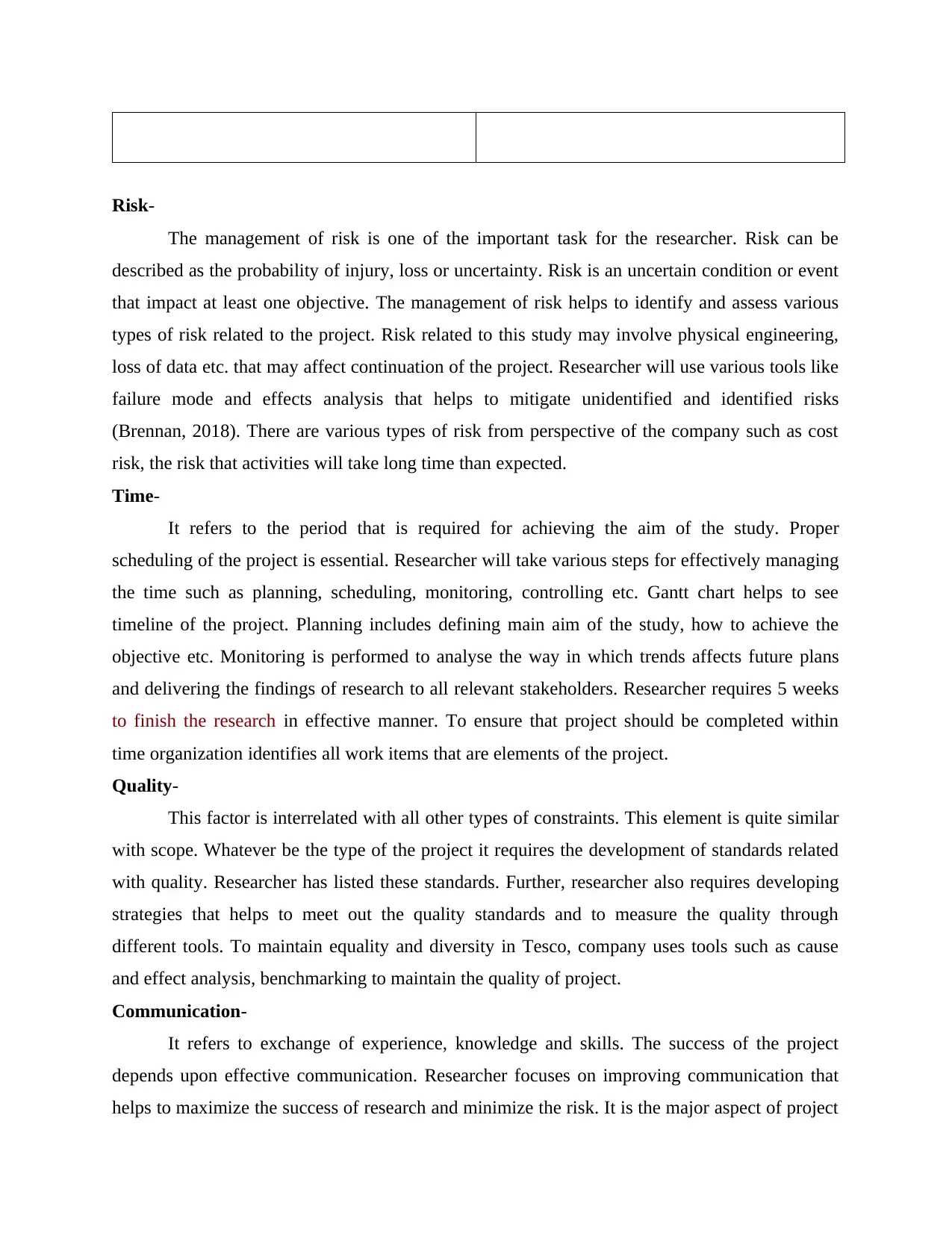
Risk-
The management of risk is one of the important task for the researcher. Risk can be
described as the probability of injury, loss or uncertainty. Risk is an uncertain condition or event
that impact at least one objective. The management of risk helps to identify and assess various
types of risk related to the project. Risk related to this study may involve physical engineering,
loss of data etc. that may affect continuation of the project. Researcher will use various tools like
failure mode and effects analysis that helps to mitigate unidentified and identified risks
(Brennan, 2018). There are various types of risk from perspective of the company such as cost
risk, the risk that activities will take long time than expected.
Time-
It refers to the period that is required for achieving the aim of the study. Proper
scheduling of the project is essential. Researcher will take various steps for effectively managing
the time such as planning, scheduling, monitoring, controlling etc. Gantt chart helps to see
timeline of the project. Planning includes defining main aim of the study, how to achieve the
objective etc. Monitoring is performed to analyse the way in which trends affects future plans
and delivering the findings of research to all relevant stakeholders. Researcher requires 5 weeks
to finish the research in effective manner. To ensure that project should be completed within
time organization identifies all work items that are elements of the project.
Quality-
This factor is interrelated with all other types of constraints. This element is quite similar
with scope. Whatever be the type of the project it requires the development of standards related
with quality. Researcher has listed these standards. Further, researcher also requires developing
strategies that helps to meet out the quality standards and to measure the quality through
different tools. To maintain equality and diversity in Tesco, company uses tools such as cause
and effect analysis, benchmarking to maintain the quality of project.
Communication-
It refers to exchange of experience, knowledge and skills. The success of the project
depends upon effective communication. Researcher focuses on improving communication that
helps to maximize the success of research and minimize the risk. It is the major aspect of project
The management of risk is one of the important task for the researcher. Risk can be
described as the probability of injury, loss or uncertainty. Risk is an uncertain condition or event
that impact at least one objective. The management of risk helps to identify and assess various
types of risk related to the project. Risk related to this study may involve physical engineering,
loss of data etc. that may affect continuation of the project. Researcher will use various tools like
failure mode and effects analysis that helps to mitigate unidentified and identified risks
(Brennan, 2018). There are various types of risk from perspective of the company such as cost
risk, the risk that activities will take long time than expected.
Time-
It refers to the period that is required for achieving the aim of the study. Proper
scheduling of the project is essential. Researcher will take various steps for effectively managing
the time such as planning, scheduling, monitoring, controlling etc. Gantt chart helps to see
timeline of the project. Planning includes defining main aim of the study, how to achieve the
objective etc. Monitoring is performed to analyse the way in which trends affects future plans
and delivering the findings of research to all relevant stakeholders. Researcher requires 5 weeks
to finish the research in effective manner. To ensure that project should be completed within
time organization identifies all work items that are elements of the project.
Quality-
This factor is interrelated with all other types of constraints. This element is quite similar
with scope. Whatever be the type of the project it requires the development of standards related
with quality. Researcher has listed these standards. Further, researcher also requires developing
strategies that helps to meet out the quality standards and to measure the quality through
different tools. To maintain equality and diversity in Tesco, company uses tools such as cause
and effect analysis, benchmarking to maintain the quality of project.
Communication-
It refers to exchange of experience, knowledge and skills. The success of the project
depends upon effective communication. Researcher focuses on improving communication that
helps to maximize the success of research and minimize the risk. It is the major aspect of project
⊘ This is a preview!⊘
Do you want full access?
Subscribe today to unlock all pages.

Trusted by 1+ million students worldwide
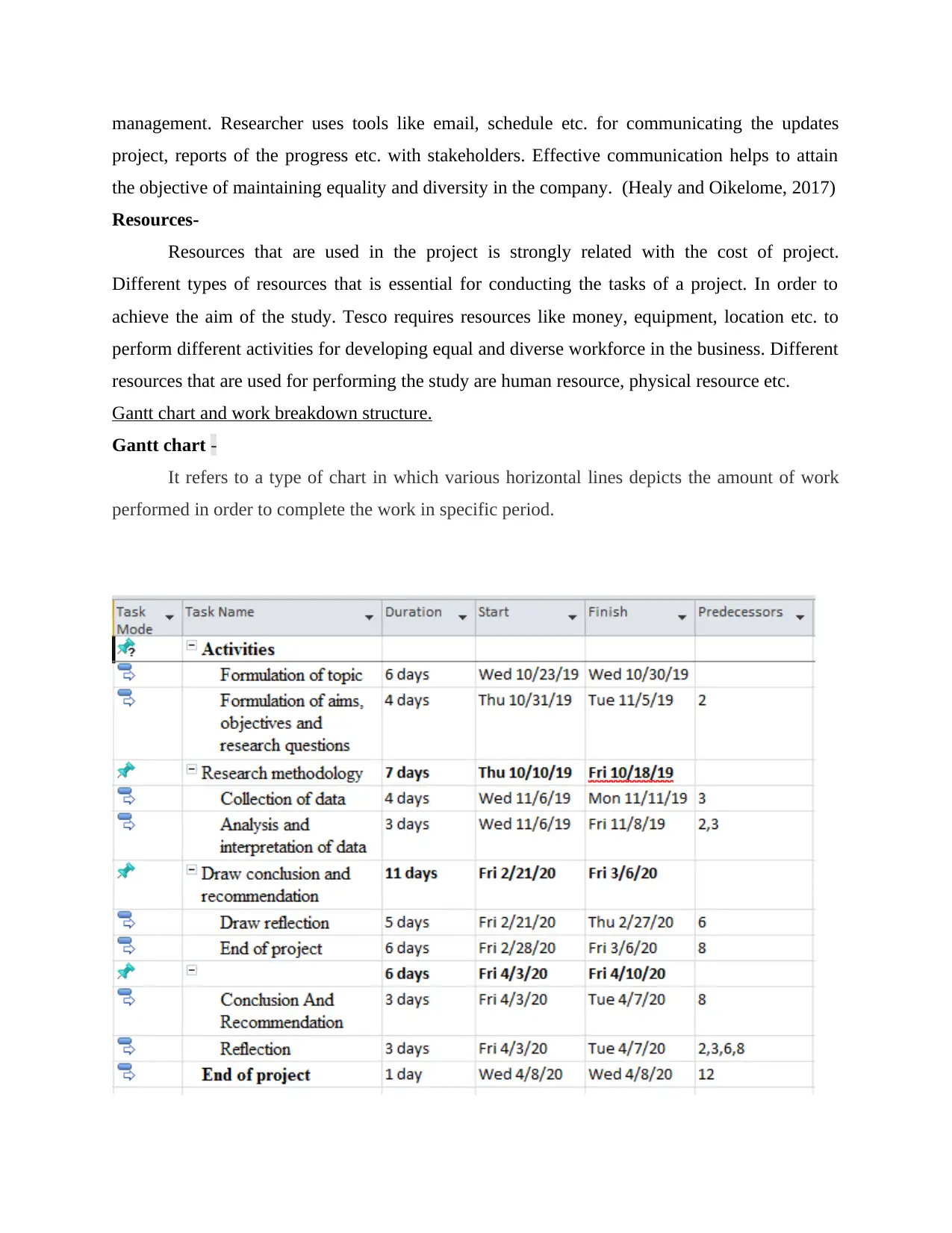
management. Researcher uses tools like email, schedule etc. for communicating the updates
project, reports of the progress etc. with stakeholders. Effective communication helps to attain
the objective of maintaining equality and diversity in the company. (Healy and Oikelome, 2017)
Resources-
Resources that are used in the project is strongly related with the cost of project.
Different types of resources that is essential for conducting the tasks of a project. In order to
achieve the aim of the study. Tesco requires resources like money, equipment, location etc. to
perform different activities for developing equal and diverse workforce in the business. Different
resources that are used for performing the study are human resource, physical resource etc.
Gantt chart and work breakdown structure.
Gantt chart -
It refers to a type of chart in which various horizontal lines depicts the amount of work
performed in order to complete the work in specific period.
project, reports of the progress etc. with stakeholders. Effective communication helps to attain
the objective of maintaining equality and diversity in the company. (Healy and Oikelome, 2017)
Resources-
Resources that are used in the project is strongly related with the cost of project.
Different types of resources that is essential for conducting the tasks of a project. In order to
achieve the aim of the study. Tesco requires resources like money, equipment, location etc. to
perform different activities for developing equal and diverse workforce in the business. Different
resources that are used for performing the study are human resource, physical resource etc.
Gantt chart and work breakdown structure.
Gantt chart -
It refers to a type of chart in which various horizontal lines depicts the amount of work
performed in order to complete the work in specific period.
Paraphrase This Document
Need a fresh take? Get an instant paraphrase of this document with our AI Paraphraser
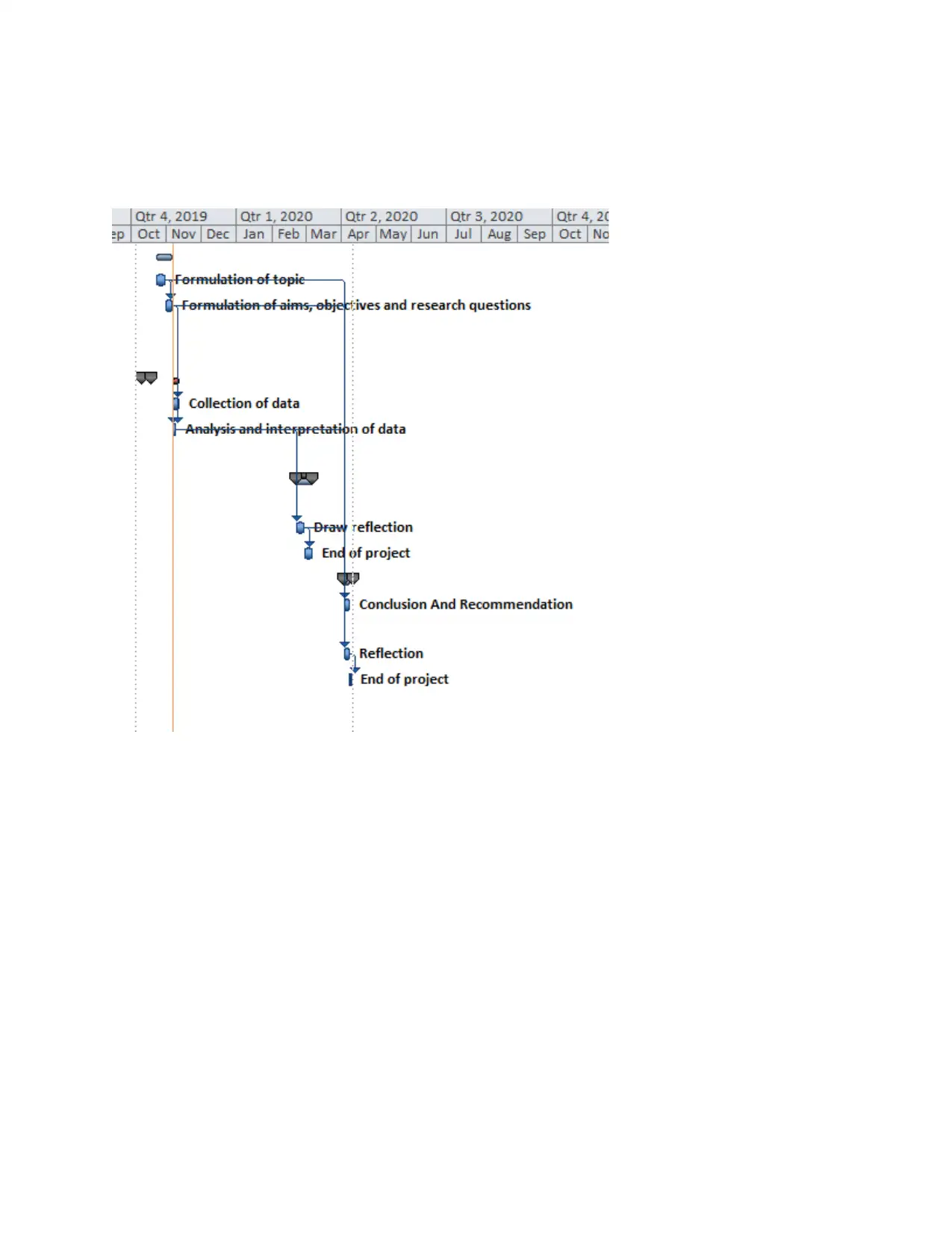
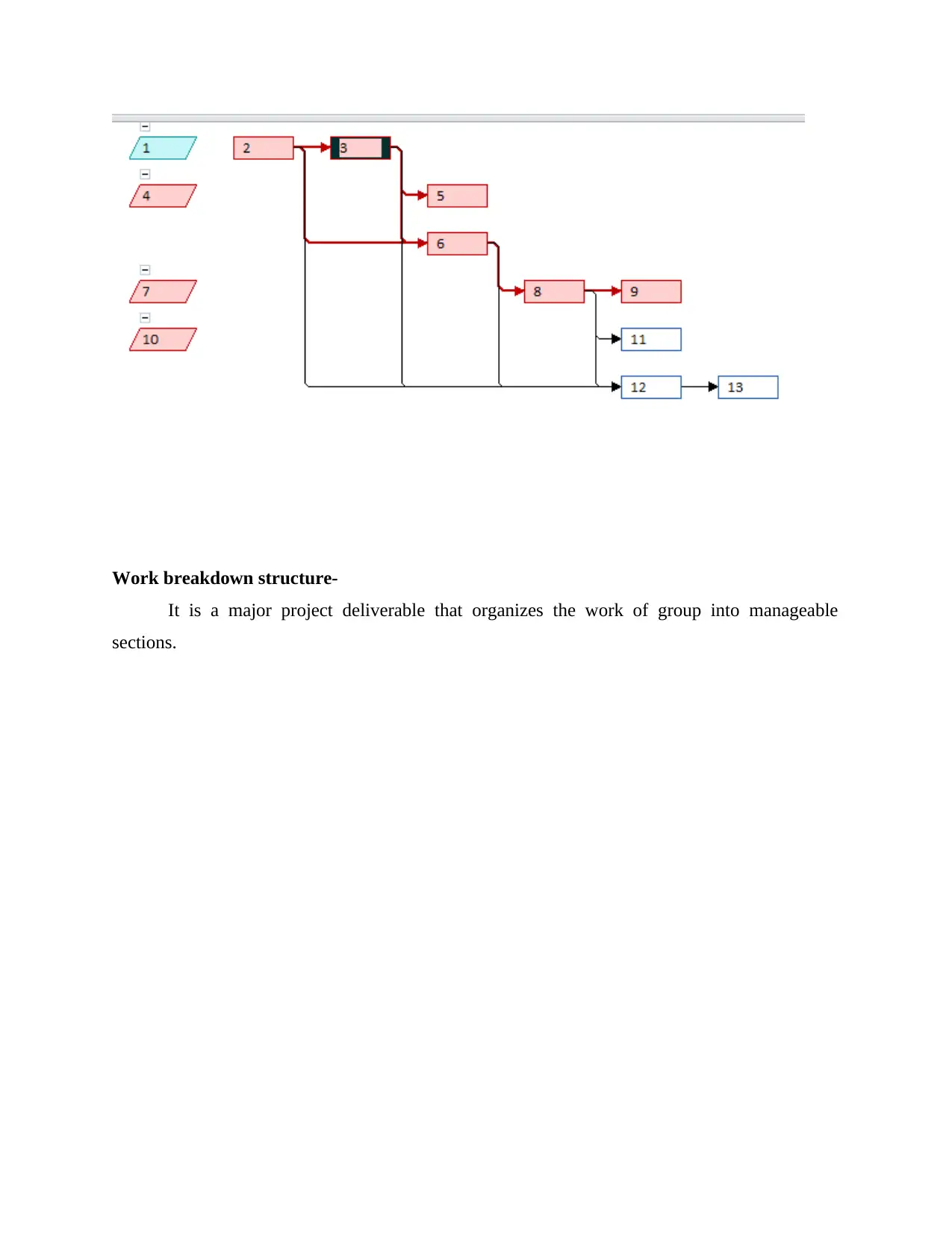
Work breakdown structure-
It is a major project deliverable that organizes the work of group into manageable
sections.
It is a major project deliverable that organizes the work of group into manageable
sections.
⊘ This is a preview!⊘
Do you want full access?
Subscribe today to unlock all pages.

Trusted by 1+ million students worldwide
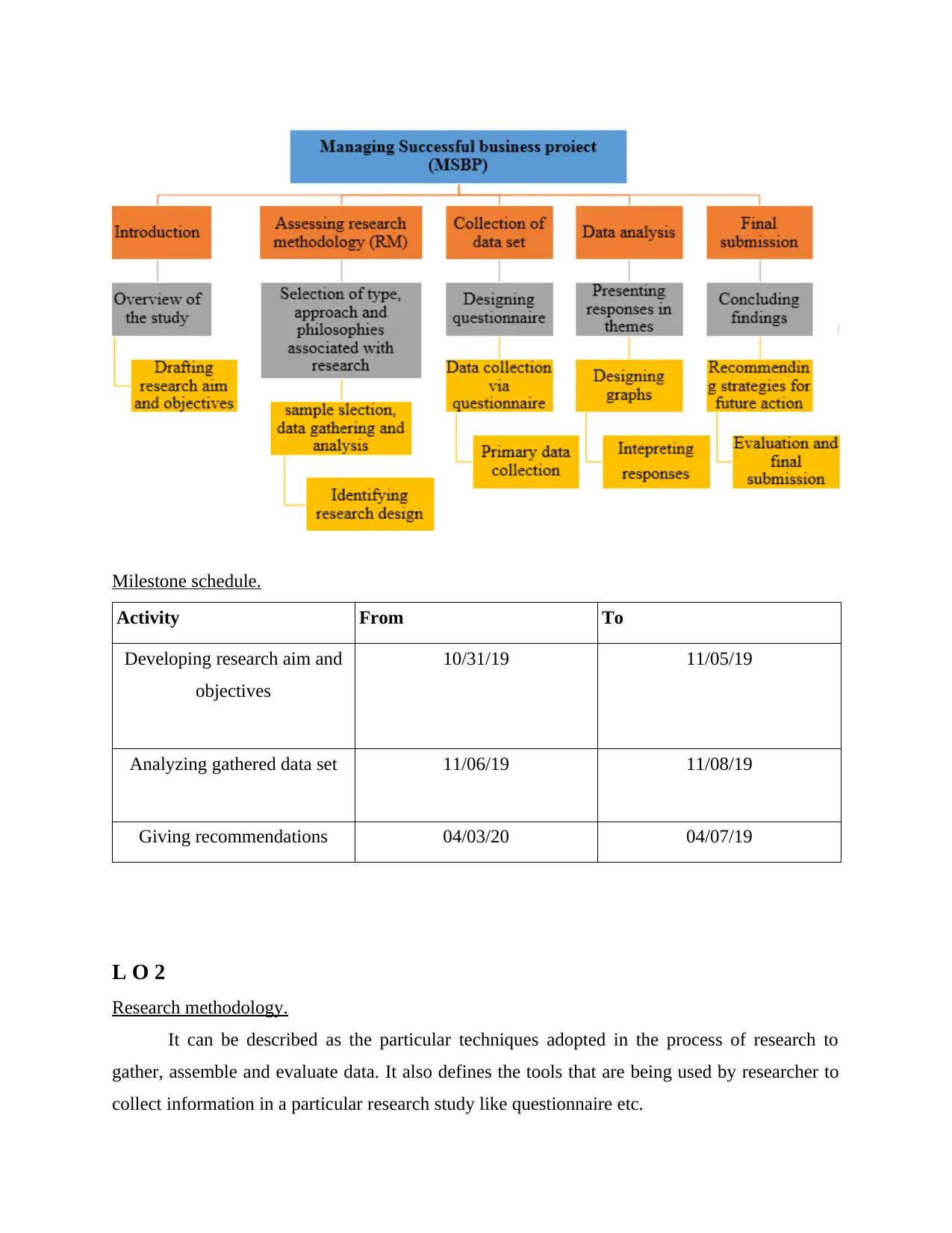
Milestone schedule.
Activity From To
Developing research aim and
objectives
10/31/19 11/05/19
Analyzing gathered data set 11/06/19 11/08/19
Giving recommendations 04/03/20 04/07/19
L O 2
Research methodology.
It can be described as the particular techniques adopted in the process of research to
gather, assemble and evaluate data. It also defines the tools that are being used by researcher to
collect information in a particular research study like questionnaire etc.
Activity From To
Developing research aim and
objectives
10/31/19 11/05/19
Analyzing gathered data set 11/06/19 11/08/19
Giving recommendations 04/03/20 04/07/19
L O 2
Research methodology.
It can be described as the particular techniques adopted in the process of research to
gather, assemble and evaluate data. It also defines the tools that are being used by researcher to
collect information in a particular research study like questionnaire etc.
Paraphrase This Document
Need a fresh take? Get an instant paraphrase of this document with our AI Paraphraser
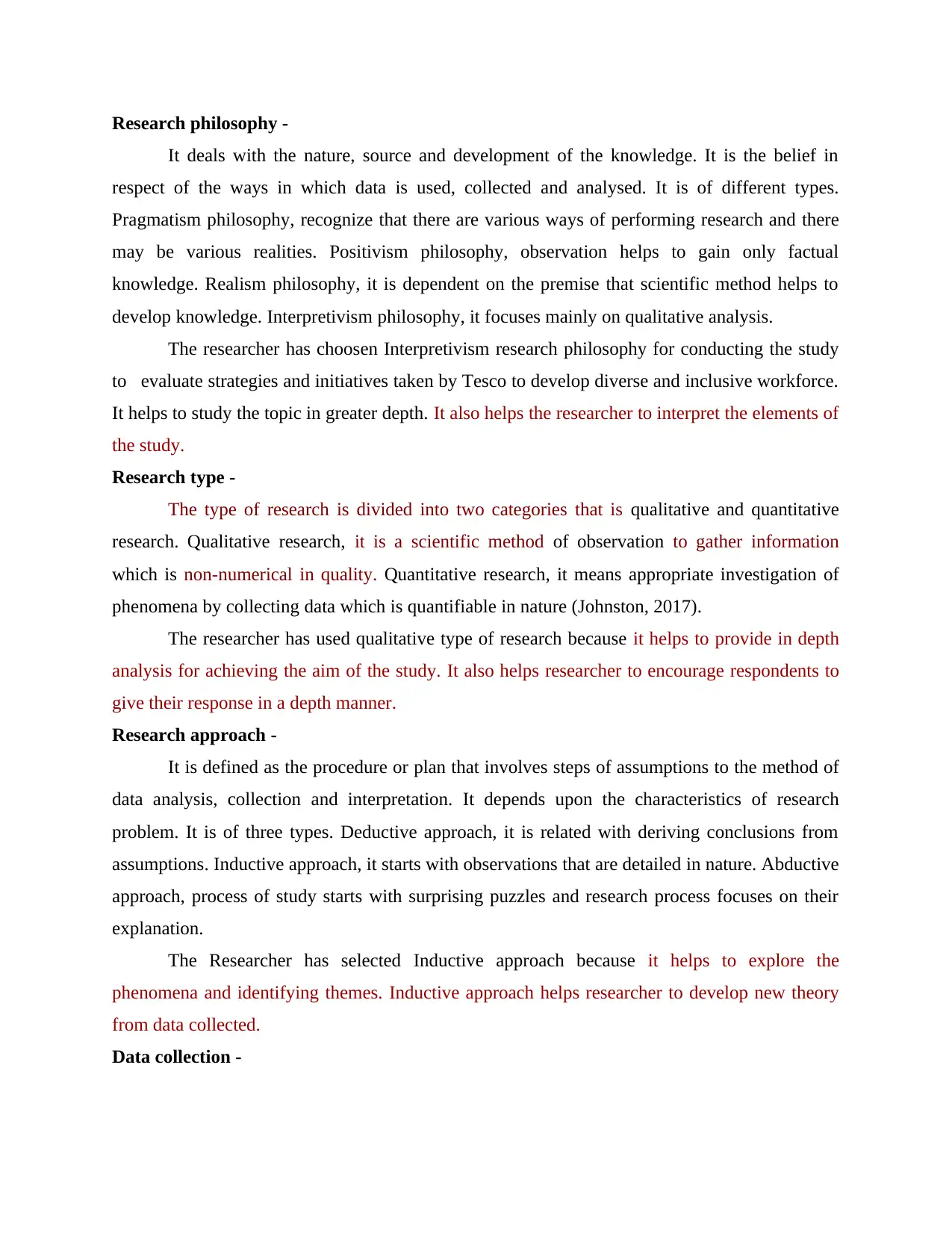
Research philosophy -
It deals with the nature, source and development of the knowledge. It is the belief in
respect of the ways in which data is used, collected and analysed. It is of different types.
Pragmatism philosophy, recognize that there are various ways of performing research and there
may be various realities. Positivism philosophy, observation helps to gain only factual
knowledge. Realism philosophy, it is dependent on the premise that scientific method helps to
develop knowledge. Interpretivism philosophy, it focuses mainly on qualitative analysis.
The researcher has choosen Interpretivism research philosophy for conducting the study
to evaluate strategies and initiatives taken by Tesco to develop diverse and inclusive workforce.
It helps to study the topic in greater depth. It also helps the researcher to interpret the elements of
the study.
Research type -
The type of research is divided into two categories that is qualitative and quantitative
research. Qualitative research, it is a scientific method of observation to gather information
which is non-numerical in quality. Quantitative research, it means appropriate investigation of
phenomena by collecting data which is quantifiable in nature (Johnston, 2017).
The researcher has used qualitative type of research because it helps to provide in depth
analysis for achieving the aim of the study. It also helps researcher to encourage respondents to
give their response in a depth manner.
Research approach -
It is defined as the procedure or plan that involves steps of assumptions to the method of
data analysis, collection and interpretation. It depends upon the characteristics of research
problem. It is of three types. Deductive approach, it is related with deriving conclusions from
assumptions. Inductive approach, it starts with observations that are detailed in nature. Abductive
approach, process of study starts with surprising puzzles and research process focuses on their
explanation.
The Researcher has selected Inductive approach because it helps to explore the
phenomena and identifying themes. Inductive approach helps researcher to develop new theory
from data collected.
Data collection -
It deals with the nature, source and development of the knowledge. It is the belief in
respect of the ways in which data is used, collected and analysed. It is of different types.
Pragmatism philosophy, recognize that there are various ways of performing research and there
may be various realities. Positivism philosophy, observation helps to gain only factual
knowledge. Realism philosophy, it is dependent on the premise that scientific method helps to
develop knowledge. Interpretivism philosophy, it focuses mainly on qualitative analysis.
The researcher has choosen Interpretivism research philosophy for conducting the study
to evaluate strategies and initiatives taken by Tesco to develop diverse and inclusive workforce.
It helps to study the topic in greater depth. It also helps the researcher to interpret the elements of
the study.
Research type -
The type of research is divided into two categories that is qualitative and quantitative
research. Qualitative research, it is a scientific method of observation to gather information
which is non-numerical in quality. Quantitative research, it means appropriate investigation of
phenomena by collecting data which is quantifiable in nature (Johnston, 2017).
The researcher has used qualitative type of research because it helps to provide in depth
analysis for achieving the aim of the study. It also helps researcher to encourage respondents to
give their response in a depth manner.
Research approach -
It is defined as the procedure or plan that involves steps of assumptions to the method of
data analysis, collection and interpretation. It depends upon the characteristics of research
problem. It is of three types. Deductive approach, it is related with deriving conclusions from
assumptions. Inductive approach, it starts with observations that are detailed in nature. Abductive
approach, process of study starts with surprising puzzles and research process focuses on their
explanation.
The Researcher has selected Inductive approach because it helps to explore the
phenomena and identifying themes. Inductive approach helps researcher to develop new theory
from data collected.
Data collection -
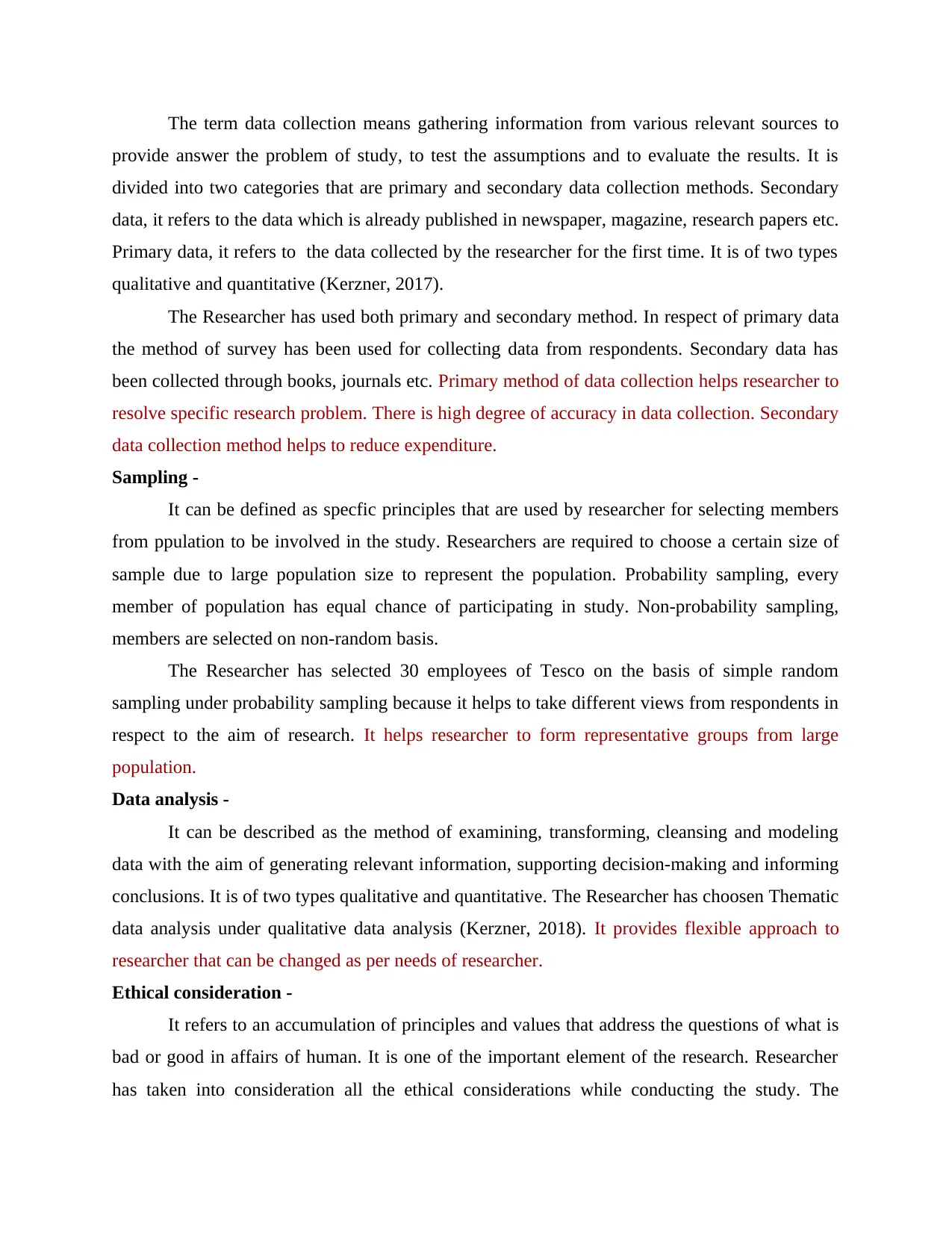
The term data collection means gathering information from various relevant sources to
provide answer the problem of study, to test the assumptions and to evaluate the results. It is
divided into two categories that are primary and secondary data collection methods. Secondary
data, it refers to the data which is already published in newspaper, magazine, research papers etc.
Primary data, it refers to the data collected by the researcher for the first time. It is of two types
qualitative and quantitative (Kerzner, 2017).
The Researcher has used both primary and secondary method. In respect of primary data
the method of survey has been used for collecting data from respondents. Secondary data has
been collected through books, journals etc. Primary method of data collection helps researcher to
resolve specific research problem. There is high degree of accuracy in data collection. Secondary
data collection method helps to reduce expenditure.
Sampling -
It can be defined as specfic principles that are used by researcher for selecting members
from ppulation to be involved in the study. Researchers are required to choose a certain size of
sample due to large population size to represent the population. Probability sampling, every
member of population has equal chance of participating in study. Non-probability sampling,
members are selected on non-random basis.
The Researcher has selected 30 employees of Tesco on the basis of simple random
sampling under probability sampling because it helps to take different views from respondents in
respect to the aim of research. It helps researcher to form representative groups from large
population.
Data analysis -
It can be described as the method of examining, transforming, cleansing and modeling
data with the aim of generating relevant information, supporting decision-making and informing
conclusions. It is of two types qualitative and quantitative. The Researcher has choosen Thematic
data analysis under qualitative data analysis (Kerzner, 2018). It provides flexible approach to
researcher that can be changed as per needs of researcher.
Ethical consideration -
It refers to an accumulation of principles and values that address the questions of what is
bad or good in affairs of human. It is one of the important element of the research. Researcher
has taken into consideration all the ethical considerations while conducting the study. The
provide answer the problem of study, to test the assumptions and to evaluate the results. It is
divided into two categories that are primary and secondary data collection methods. Secondary
data, it refers to the data which is already published in newspaper, magazine, research papers etc.
Primary data, it refers to the data collected by the researcher for the first time. It is of two types
qualitative and quantitative (Kerzner, 2017).
The Researcher has used both primary and secondary method. In respect of primary data
the method of survey has been used for collecting data from respondents. Secondary data has
been collected through books, journals etc. Primary method of data collection helps researcher to
resolve specific research problem. There is high degree of accuracy in data collection. Secondary
data collection method helps to reduce expenditure.
Sampling -
It can be defined as specfic principles that are used by researcher for selecting members
from ppulation to be involved in the study. Researchers are required to choose a certain size of
sample due to large population size to represent the population. Probability sampling, every
member of population has equal chance of participating in study. Non-probability sampling,
members are selected on non-random basis.
The Researcher has selected 30 employees of Tesco on the basis of simple random
sampling under probability sampling because it helps to take different views from respondents in
respect to the aim of research. It helps researcher to form representative groups from large
population.
Data analysis -
It can be described as the method of examining, transforming, cleansing and modeling
data with the aim of generating relevant information, supporting decision-making and informing
conclusions. It is of two types qualitative and quantitative. The Researcher has choosen Thematic
data analysis under qualitative data analysis (Kerzner, 2018). It provides flexible approach to
researcher that can be changed as per needs of researcher.
Ethical consideration -
It refers to an accumulation of principles and values that address the questions of what is
bad or good in affairs of human. It is one of the important element of the research. Researcher
has taken into consideration all the ethical considerations while conducting the study. The
⊘ This is a preview!⊘
Do you want full access?
Subscribe today to unlock all pages.

Trusted by 1+ million students worldwide
1 out of 32
Related Documents
Your All-in-One AI-Powered Toolkit for Academic Success.
+13062052269
info@desklib.com
Available 24*7 on WhatsApp / Email
![[object Object]](/_next/static/media/star-bottom.7253800d.svg)
Unlock your academic potential
Copyright © 2020–2025 A2Z Services. All Rights Reserved. Developed and managed by ZUCOL.





